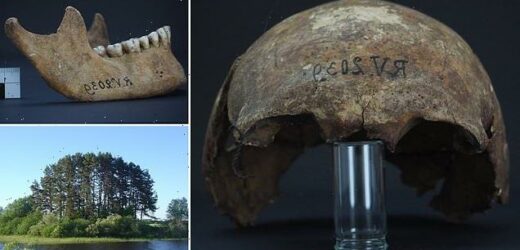Meet Europe’s oldest plague victim: Earliest strain of the bacteria behind Black Death is discovered in a 5,000-year-old skeleton in Latvia
- Scientists identify the Yersinia pestis bacterium in a man buried 5,000 years ago
- At the time the bacterium was far less contagious and not as deadly for humans
- But it evolved over the course of about 4,300 years leading to the Black Death
- Also known as the great plague, the outbreak ravaged Europe from 1346 to 1353
Scientists have found the earliest strain of Yersinia pestis – the bacteria that caused the Black Death, a devastating bubonic plague pandemic in the 14th century.
Y. pestis was found in the 5,000-year-old remains of a male hunter-gatherer, dubbed RV 2039, in a region called Rinnukalns in present-day Latvia.
Genetic analysis reveals that this ancient strain was likely less contagious and not as deadly as the medieval version during the Black Death.
This early form of the plague that killed RV 2039, around the year 3,000 BC, likely was a slow-moving disease and wasn’t very transmissible.
Over the next 4,300 years, however, the strain evolved to become more deadly to humans, culminating in the catastrophic Black Death in Europe and Africa.
It’s though the Black Death – which lasted from 1346 to 1353 – could have killed as much as half of Europe’s population.
This image shows the skull bones of RV 2039, a man buried in Rinnukalns, Latvia, around 5,000 years ago
Pictured, a depiction of plague victims being buried during the Black Death. The devastating bubonic plague pandemic ravaged Europe from 1346 to 1353
THE DEADLY PLAGUE
Plague is an infectious disease caused by the bacterium Yersinia pestis, which is carried by fleas and transmitted between animals.
The bubonic plague – the most common form – is caused by the bite of an infected flea and can spread through contact with infectious bodily fluids or contaminated materials.
Patients may show signs of fever and nausea and at an advanced stage may develop open sores filled with pus.
It devastated Europe in the Middle Ages, most notably in the Black Death of the 1340s which killed a third or more of the continent’s population.
After the Black Death plague became a common phenomenon in Europe, with outbreaks recurring regularly until the 18th century.
When the Great Plague of 1665 hit, a fifth of people in London died, with victims shut in their homes and red crosses painted on the door.
Bubonic plague has almost completely vanished from the rich world. 90 per cent of all cases are now in Africa.
It is now treatable with antibiotics, as long as they are administered quickly.
Still, there have been a few non-fatal cases in the U.S., with an average of seven reported a year, according to disease control bosses.
From 2010 to 2015 there were 3,248 cases reported worldwide, including 584 deaths, says the World Health Organisation.
The genetic analysis of RV 2039 was led by Ben Krause-Kyora, a biochemist and archaeologist at the University of Kiel in Germany.
‘What’s most astonishing is that we can push back the appearance of Y. pestis 2,000 years farther than previously published studies suggested,’ he said.
‘It seems that we are really close to the origin of the bacteria.’
RV 2039, who would have been between 20 and 30 years old at time of death, was actually one of two people whose skeletons were excavated in the late 1800s in Rinnukalns.
Soon after their remains were found, both vanished until 2011, when they reappeared as part of German anthropologist Rudolph Virchow’s collection.
After this rediscovery, two more burials were uncovered from the site to give a total of four specimens, likely from the same group of hunter-gatherers.
Krause-Kyora and his team used samples from the teeth and bone of all four to sequence their genomes and then tested them for bacterial and viral pathogens.
They were surprised to find evidence of Y. pestis in RV 2039, but not the other three specimens.
After reconstructing the bacteria’s genome and comparing it to other ancient strains, the team realised the Y. pestis strain that RV 2039 carried was the oldest strain ever discovered.
It was likely part of a lineage that emerged about 7,000 years ago, only a few hundred years after Y. pestis split from its predecessor, Yersinia pseudotuberculosis.
‘What’s so surprising is that we see already in this early strain more or less the complete genetic set of Y. pestis, and only a few genes are lacking,’ said Krause-Kyora.
‘But even a small shift in genetic settings can have a dramatic influence on virulence.’
Y. pestis can infect humans via the Oriental rat flea (Xenopsylla cheopis), which is carried – as the name suggests – by rodents.
However, this newly-found ancient strain lacked one crucial element – the gene that first let fleas act as vectors to spread the plague.
This gene was responsible for efficient transmission of the bacterium to human hosts, which resulted in the growth of the grotesque pus-filled buboes in the sick associated with the Black Death.
Flea-based transmission also required the death of the human host, which means that the appearance of the gene could have driven the evolution of a deadlier disease.
From RV 2039, it likely took more than 1,000 years for Y. pestis to acquire all the mutations needed for flea-based transmission.
But it’s not clear the extent to which RV 2039 experienced the nastiest effects of the plague – buboes, bleeding and weakness, to name a few.
Although Y. pestis was found in his bloodstream, meaning he most likely died from the bacterial infection, the course of the disease might have been fairly slow.
Researchers observed that he had a high number of Y. pestis in his bloodstream at his time of death. But in previous rodent studies, a high bacterial load of Y. pestis has been associated with less aggressive infections.
The Rinnukalns, a Stone Age shell midden on the banks of the Salaca River near the outflow from Lake Burtniek
Additionally, the people he was buried near were not infected, which makes a highly contagious respiratory version of the plague less likely.
The 5,000-year-old strain was likely transmitted directly via a bite from an infected rodent and probably didn’t spread beyond RV 2039.
Some historians have suggested that infectious diseases like Y. pestis evolved mostly in cities containing more than 10,000 people near the Black Sea.
However, 5,000 years ago – the age of RV 2039’s strain – was long before the formation of large cities, which puts these theories in doubt.
Instead, agriculture was just beginning to appear in Central Europe, and populations were much sparser.
3D illustration of Yersinia pestis – the bacteria behind the the Black Death in the 14th century
This new study also contradicts an idea that Y. pestis led to the large population declines in Western Europe at the late Neolithic period (3000 to 2500 BC).
The authors say that examining the history of Y. pestis could also potentially shed light on human genomic history.
‘Different pathogens and the human genome have always evolved together,’ said Krause-Kyora.
‘We know Y. pestis most likely killed half of the European population in a short time frame, so it should have a big impact on the human genome.
‘But even before that, we see major turnover in our immune genes at the end of the Neolithic Age, and it could be that we were seeing a significant change in the pathogen landscape at that time as well.’
The study has been published in the journal Cell Reports.
BUBONIC PLAGUE: WIPED OUT A THIRD OF EUROPE IN THE 14TH CENTURY
Bubonic plague is one of the most devastating diseases in history, having killed around 100million people during the ‘Black Death’ in the 14th century.
Drawings and paintings from the outbreak, which wiped out about a third of the European population, depict town criers saying ‘bring out your dead’ while dragging trailers piled with infected corpses.
It is caused by a bacterium known as Yersinia pestis, which uses the flea as a host and is usually transmitted to humans via rats.
The disease causes grotesque symptoms such as gangrene and the appearance of large swellings on the groin, armpits or neck, known as ‘buboes’.
It kills up to two thirds of sufferers within just four days if it is not treated, although if antibiotics are administered within 24 hours of infection patients are highly likely to survive.
After the Black Death arrived in 1347 plague became a common phenomenon in Europe, with outbreaks recurring regularly until the 18th century.
Bubonic plague has almost completely vanished from the rich world, with 90 per cent of all cases now found in Africa.
However, there have been a few non-fatal cases in the U.S. in recent years, while in August 2013 a 15-year-old boy died in Kyrgyzstan after eating a groundhog infected with the disease.
Three months later, an outbreak in a Madagascan killed at least 20 people in a week.
A year before 60 people died as a result of the infection, more than in any other country in the world.
Outbreaks in China have been rare in recent years, and most have happened in remote rural areas of the west.
China’s state broadcaster said there were 12 diagnosed cases and three deaths in the province of Qinghai in 2009, and one in Sichuan in 2012.
In the United States between five and 15 people die every year as a result, mostly in western states.
Source: Read Full Article





